Birdfinding.info ⇒ The “devil owl” (mocho-diabo) from Hades (the meaning of “Stygian”) is secretive and rarely encountered across most of its range. Some areas where it has been found regularly include: the Mountain Pine Ridge Forest Reserve in Belize; the western mountains and Zapata Swamp region of Cuba; Alcoa Road in the Dominican Republic; the San Lorenzo road, the Manizales area, and urban parks in Bogotá, Colombia; urban parks in Quito, Ecuador; and urban parks in São Paulo, Brazil.
Stygian Owl
Asio stygius
Widely but patchily distributed in Neotropical forests from Mexico and Cuba to Argentina.
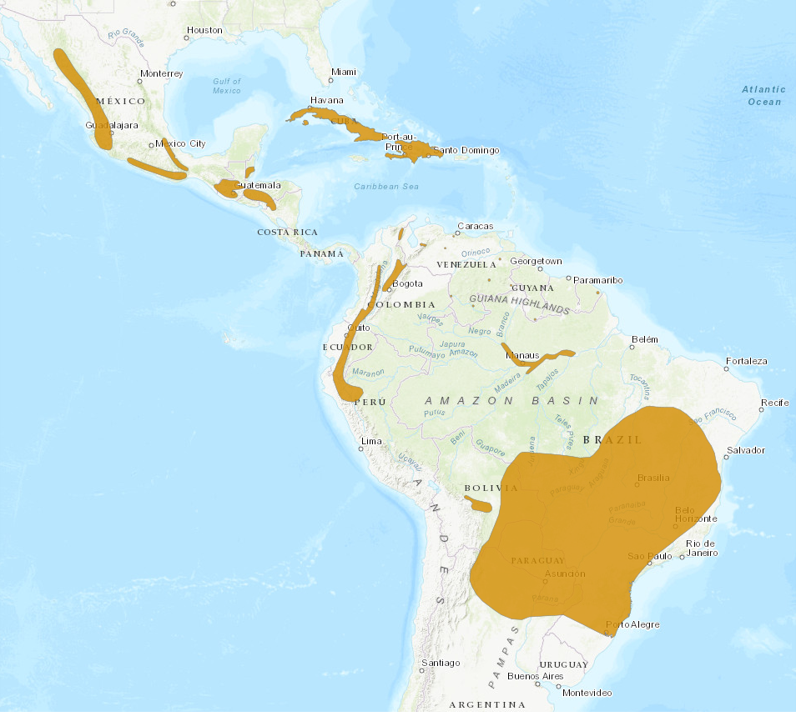
Approximate distribution of the Stygian Owl. © BirdLife International 2016
The full extent of its range is not well understood due to its generally secretive nature, so it is likely more widespread than existing records indicate. Occurs in various types of forests and brushlands in five somewhat separate regions:
1) Middle America, mainly in montane pine-oak forests from both slopes of Mexico (southern Sonora and central Tamaulipas) and Belize south to northern Nicaragua.
2) Cuba, the Isle of Youth, Hispaniola, and Gonâve, where it occurs locally in forests at all elevations.
3) Middle and lower elevations (up to 3100 m) of the Sierra de Santa Marta, the coastal ranges of Venezuela, and the Andes of western Venezuela, Colombia, and Ecuador; then more patchily southward on the eastern slopes and foothills of the Andes to northwestern Argentina (to Catamarca).

Brazilian records of the Stygian Owl, by municipality. © WikiAves 2023
4) North-central South America, where it has been recorded patchily from the Tepui region, along the lower Amazon River and in south-central Amazonia. (Note that the records in theses areas are very few and widely scattered, and it is not clear whether they represent any durable resident populations.)
5) Central and eastern South America from eastern Bolivia (Santa Cruz), Mato Grosso, Goiás, and northern Bahia south through the Chaco, the central and southern cerrado, and the southern Atlantic Forest region to northern Argentina (to Chaco and Misiones) and Rio Grande do Sul.
Adapts to urban areas, as shown by a pattern of appearing in urban parks in many South American cities, where it roosts in dense groves of trees and likely forages on the abundant rodents and city birds.
Not known to migrate but evidently has a tendency to disperse, as indicated by records from southern Texas, Key West, Florida.
Identification
A medium-large owl with predominantly dark plumage and narrow, close-set ear-tufts. Mostly nocturnal; only occasionally active in daylight.
The facial disk is frosty-brown with a whitish rim and a prominent whitish diamond between the eyes.
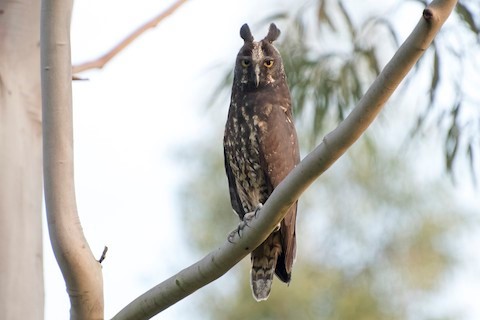
Stygian Owl, in tall-thin posture, showing all-dark-brown upperparts and whitish patch between the eyes. (Edmundo Navarro de Andrade State Forest, São Paulo, Brazil; April 29, 2017.) © Luiz Carlos Ramasotti
The upperparts are mostly dark-brown or blackish, with whitish flecks and bars interspersed.
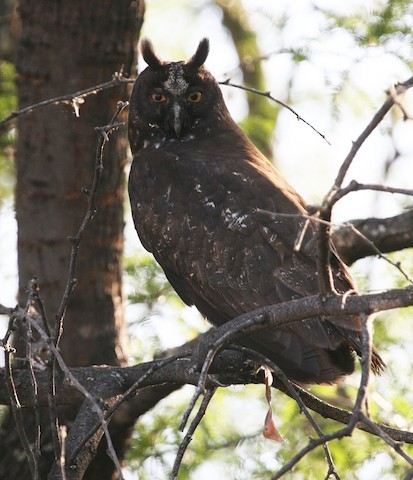
Stygian Owl, with sparse, thin white flecks on its dark-brown upperparts. (Nuri, Sonora, Mexico; May 13, 2012.) © Dean LaTray
The underparts vary from whitish to buffy with dark brown chevrons that are usually dense on the chest and become progressively sparser toward the belly.
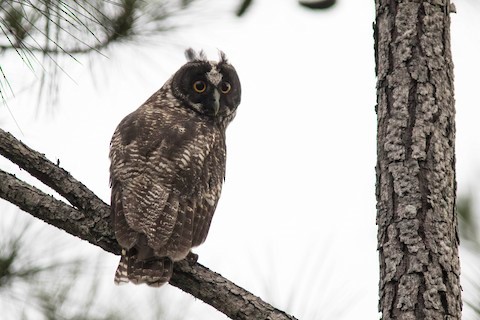
Stygian Owl, with atypically extensive white flecks and bar on its upperparts. (Noj Kaax H’Men Elijio Panti Forest Reserve, Belize; July 2, 2017.) © Bryce Robinson
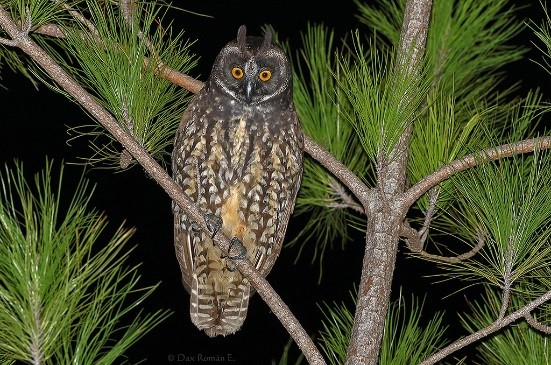
Stygian Owl, showing typical underparts pattern and coloration. (Alcoa Road, Dominican Republic; December 12, 2014.) © Dax M. Román E.
Notes
Polytypic species consisting of four recognized subspecies.
More Images of the Stygian Owl

Stygian Owl. (Alcoa Road, Dominican Republic; March 15, 2017.) © Juan Taveras
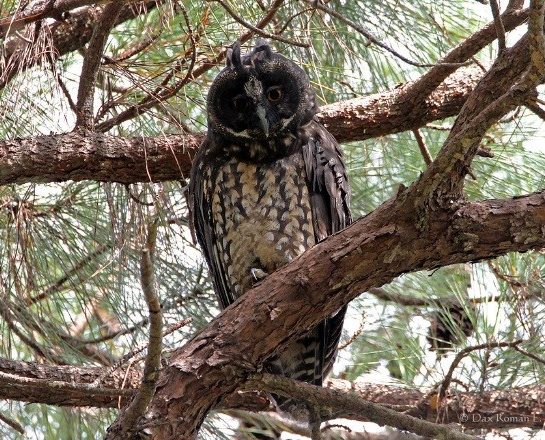
Stygian Owl. (Alcoa Road, Dominican Republic; August 3, 2012.) © Dax M. Román E.

Stygian Owl. (Dawson Creek & Lamanai Savanna, Orange Walk, Belize; August 9, 2018.) © Jorge Eduardo Ruano
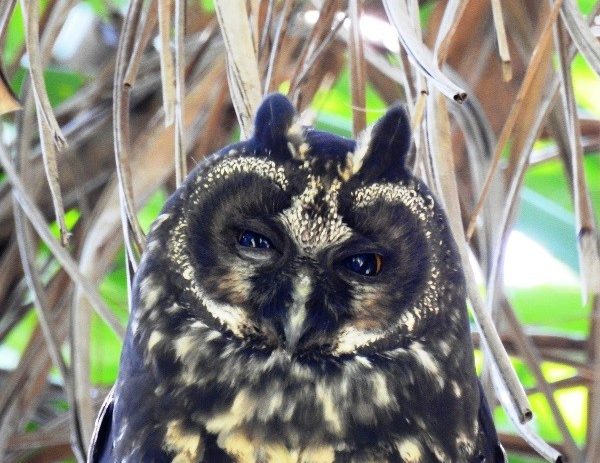
Stygian Owl, showing whitish rim and central diamond on facial disk. (Parque Ibirapuera, São Paulo, Brazil; October 23, 2018.) © Pedro Henrique Maloso Ramos

Stygian Owl. (Veredea Alto de Medina, Antioquia, Colombia; May 19, 2019.) © Andrés Posada

Stygian Owl, showing white flecks and bars on its dark-brown upperparts. (Hidden Valley Inn, Mountain Pine Ridge Forest Reserve, Belize; July 27, 2009.) © Aldo Ortíz Reyes

Stygian Owl. (Palpite, Matanzas, Cuba; February 14, 2016.) © Joshua D. Vandermeulen

Stygian Owl. (Parque Ibirapuera, São Paulo, Brazil; October 23, 2018.) © Pedro Henrique Maloso Ramos
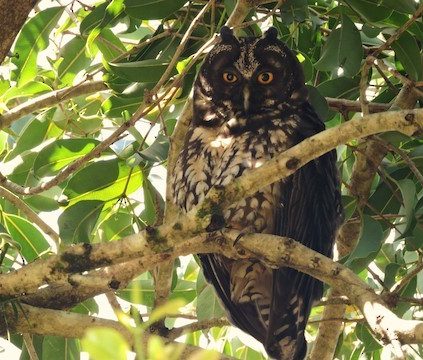
Stygian Owl. (Guaraú, São Paulo, Brazil; August 28, 2016.) © Fábio Barata

Stygian Owl. (Brasília Forest Reserve, Federal District, Brazil; August 27, 2014.) © Cláudia Brasileiro
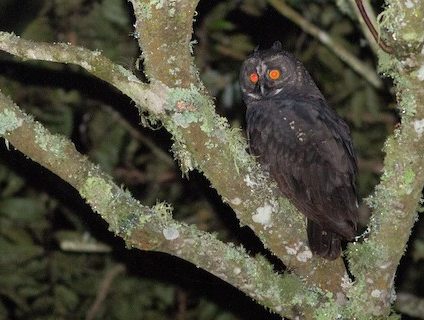
Stygian Owl. (Pululahua Geobotanical Reserve, Pichincha, Ecuador; June 7, 2018.) © Angus Pritchard

Stygian Owl—a dark individual with limited whitish rim and central diamond on facial disk. (Waqanqe Orchid Garden, Moyabamba, San Martín, Peru; May 9, 2013.) © Alan Van Norman

Stygian Owl, showing whitish rim and central diamond on facial disk. (Parque Barrio Castilla, Bogotá, Colombia; February 8, 2017.) © Diego Emerson Torres

Stygian Owl, showing dark-brown upperparts with only sparse, thin white flecks. (Humedal Jaboque, Bogotá, Colombia; February 21, 2013.) © Neil Orlando Diaz Martinez
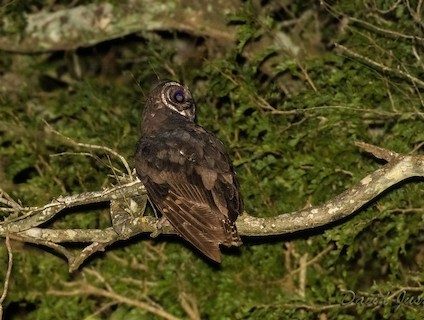
Stygian Owl, with entirely dark-brown upperparts. (Pampa del Indio, Libertador General San Martín, Chaco, Argentina; July 8, 2016.) © David Juszczuk

Stygian Owl. (Las Terrazas, Sierra del Rosario Biosphere Reserve, Cuba; January 26, 2018.) © Felipe Pimentel

Stygian Owl. (Hidden Valley Inn, Mountain Pine Ridge Forest Reserve, Belize; June 25, 2018.) © Jorge Eduardo Ruano

Stygian Owl. (Waqanqe Orchid Garden, Moyabamba, San Martín, Peru; May 9, 2013.) © Alan Van Norman
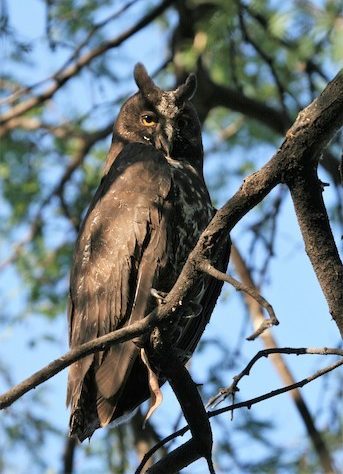
Stygian Owl. (Nuri, Sonora, Mexico; May 13, 2012.) © Dean LaTray

Stygian Owl. (Dawson Creek & Lamanai Savanna, Orange Walk, Belize; August 9, 2018.) © Jorge Eduardo Ruano
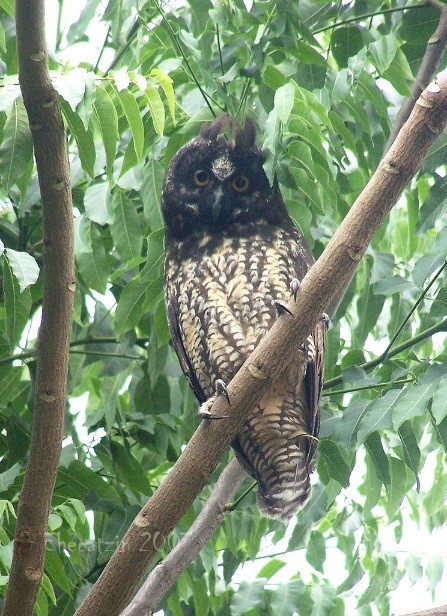
Stygian Owl. (Ciudad Victoria, Tamaulipas, Mexico; June 25, 2007.) © Aldo Ortíz Reyes

Stygian Owl. (Cienfuegos Botanical Garden, Cienfuegos, Cuba; March 19, 2017.) © R. Dennis Ringer
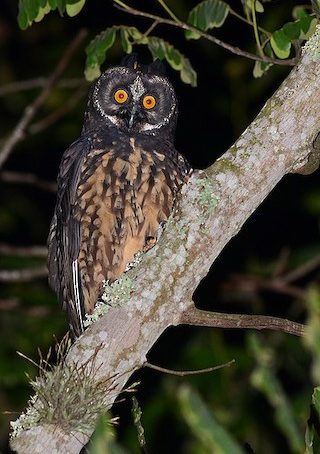
Stygian Owl. (Quatis, Rio de Janeiro, Brazil; January 4, 2016.) © Bruno Rennó
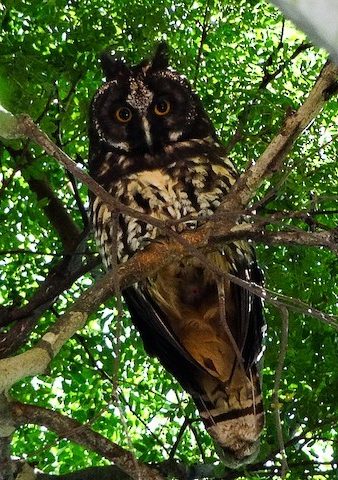
Stygian Owl. (São Paulo, Brazil; February 1, 2018.) © Clément Delaleu
References
Alderfer, J., and J.L. Dunn. 2014. National Geographic Complete Birds of North America (Second Edition). National Geographic Society, Washington, D.C.
Ascanio, D., G.A. Rodriguez, and R. Restall. 2017. Birds of Venezuela. Christopher Helm, London.
BirdLife International. 2016. Asio stygius. The IUCN Red List of Threatened Species 2016: e.T22689504A95214500. http://dx.doi.org/10.2305/IUCN.UK.2016-3.RLTS.T22689504A95214500.en. (Accessed December 1, 2023.)
eBird. 2019. eBird: An online database of bird distribution and abundance. Cornell Lab of Ornithology, Ithaca, N.Y. http://www.ebird.org. (Accessed December 1, 2023.)
Fagan, J., and O. Komar. 2016. Peterson Field Guide to the Birds of Northern Central America. Houghton Mifflin Harcourt, New York.
Garrido, O.H, and A. Kirkconnell. 2000. Field Guide to the Birds of Cuba. Cornell University Press, Ithaca, N.Y.
Howell, S.N.G., and S. Webb. 1995. A Guide to the Birds of Mexico and Northern Central America. Oxford University Press, Oxford.
iNaturalist. 2023. https://www.inaturalist.org/. (Accessed December 1, 2023.)
Kirwan, G.M., A. Levesque, M. Oberle, and C.J. Sharpe. 2019. Birds of the West Indies. Lynx Edicions, Barcelona.
König, C., and F. Weick. 2008. Owls of the World (Second Edition). Yale University Press, New Haven.
Latta, S., C. Rimmer, A. Keith, J. Wiley, H. Raffaele, K. McFarland, and E. Fernandez. 2006. Birds of the Dominican Republic and Haiti. Princeton University Press, Princeton, N.J.
McMullan, M., and T. Donegan. 2014, Field Guide to the Birds of Colombia (Second Edition). Fundación Proaves de Colombia, Bogotá.
Mikkola, H. 2013. Owls of the World: A Photographic Guide (Second Edition). Firefly Books, London.
Raffaele, H., J. Wiley, O. Garrido, A. Keith and J. Raffaele. 1998. A Guide to the Birds of the West Indies. Princeton University Press, Princeton, N.J.
Ridgely, R.S., and P.J. Greenfield. 2001. The Birds of Ecuador, Volume II: Field Guide. Cornell University Press, Ithaca, N.Y.
Schulenberg, T.S., D.F. Stotz, D.F. Lane, J.P. O’Neill, and T.A. Parker. 2007. Birds of Peru. Princeton University Press, Princeton, N.J.
van Perlo, B. 2009. A Field Guide to the Birds of Brazil. Oxford University Press, Oxford.
Wikiaves. 2023. Mocho-diabo, https://www.wikiaves.com.br/wiki/mocho-diabo. (Accessed December 1, 2023.)
